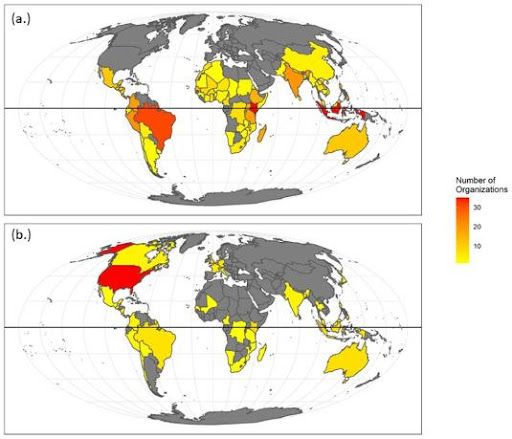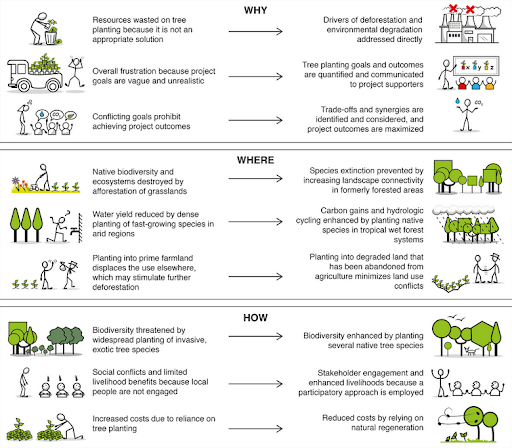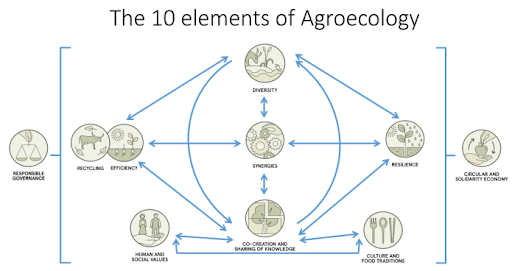Why planting tree is not the miracle solution


· 7 min read
There are countless companies using carbon storage via reforestation to offset their emissions. South America, Amazonia, Java, Kenya... these projects are multiplying, and are often pinned by NGOs for greenwashing. But how much of an impact does this method really have?
During the last decades, we could observe enthusiasm about replanting trees as the most efficient way to achieve climate change mitigation. Indeed, during its growth, a tree has quite an important role in CO2’s withdrawal from the atmosphere. Trees store the carbon in the trunk, the branches or the roots and the soil in the form of organic components. Thus, when the tree dies, the carbon is released. This phenomenon takes place in all types of forests across the world, and can represent complete healthy and natural ecosystems, thanks to the new trees.Many studies argue that it’s currently the most efficient natural solution for climate change, and planting 1.2 trillion trees would absorb ⅔ of the human-made CO2 emissions produced.
This replanting trees solution, which seems to be the new miracle solution to save the planet, is not as simple as it seems. There are several positive impacts such as carbon retention, but there is a strong carry-over effect on the environment and populations. In some cases, planting trees leads to biodiversity loss, groundwater pumping, and profound changes in the soil restoration cycle. Most of the time, this solution looks more like a reprieve for the planet and the least-worst solution, due to the huge problems it also creates.
Organizations present planting trees projects as projects taking biodiversity into account by proposing systems with several varieties of trees mixed together, or relying on known techniques to regenerate existing systems. These projects suggest that biodiversity, social or environmental aspects are taken into account. But when taking a closer look at these initiatives, we can observe that most of the time, cacao, teak, moringa, mango and coffee are the most planted trees. These species are commercial or utilitarian and can cover the initial biodiversity of the land and lead to biotic homogenization.
In addition, these initiatives take place in an emergency context and don't consider the time and location factor. Trees need at least 10 years to be able to absorb carbon emission, plus absorption capacities for each species are variable. Climate and the age of the tree have a role in the “efficiency” of this kind of project.

Most of the time, these policies are implemented in developing countries but designed in developed countries. We can wonder about the follow-up of these projects after the trees have been planted.
As mentioned earlier, planting trees doesn’t reduce existing carbon emission but store it until the tree dies or burns, there is a carbon release. The quality is as important as the quantity in these types of initiatives. After planting, management modality is a key success factor. But when we look at organizations’ reports involved in planting tree projects, only 18% of them mention monitoring and only 5% address the issue of survival rate. There is a clear lack of monitoring for these initiatives, and without this parameter taken into account, it’s just a postponement of the problem that we will have to address later, in even more important ways.
These solutions are not socially sustainable either: tree planting projects and policies includes local communities as much as possible, and therefore can help them by creating jobs. But these initiatives, even the bigger ones, are planned for short or mid-term and do not create sustainable social solutions for these fragile populations. More than that, the populations usually solicited for reforestation projects initially already have income, sometimes more important than what companies offer, thanks to natural forests helping 1.6 billion people in the world to have revenue.
When planting trees, you need to consider hydrological cycles, carbon, temperatures,albedo, biodiversity, social and economic issues. Natural forests across the world currently host ⅔ living species, providing help for grounds and water stability which contributes to get 1.6 billion persons in the world a revenue.
To be able to deal with climate change, we need to be able to go further than the minimum solution of Net zero, or even the Net positive which wants to offer a positive contribution to the global. We need to think of a more holistic solution, deeply rooted in the environment, where the solution comes from, to offer more integrated solutions from a sustainability perspective.
We can have a look at regenerative design, well-explained by Bowie Yin Sum Kung in her article. It’s a solution which goes further than traditional sustainable solutions by creating a more sustainable solution-system and goes beyond the simple consideration of environmental impact. Regenerative solutions are solutions that consider Societies, Mother Earth, Culture, Politics, Economy and Society to propose holistic solutions. Instead of just thinking of a socio-environmental restoration, regenerative design is about active regeneration & transformation. (Read more to go further on the subject).

According to Brancalion and Holl methodology, the most important factors to improve in these type of project are:
This new paradigm could be a new entire system that solves many problems at the same time, and that is why I wanted to conclude this article by opening the discussion about agroecology. In order to meet the growing food needs due to the increase in world population, but also to find the best environmental and climatic compromise, many disciplines have emerged such as organic farming, conservation agriculture, eco-agriculture and also the discipline in which we are interested today, agroecology. In agroecology, the notion of resilience is the capacity of an ecosystem, after more or less strong disturbance, to return to its original state. As it is an important concept, this principle seems to be in total adequation with regenerative design.
Agroecology is a scientific discipline but also a movement and a social practice. The scientific aspect of agroecology comes from its base of agronomy combined with ecology in its original sense: a better balance between man and his natural environment and the protection of the latter. The social movement is defined by the local aspect of this practice. Agroecology is based on the use of local resources to make the region self-sufficient based on local employment. It is above all a practice from the creation to the promotion of production methods responding to the environmental and climatic issues previously stated. This interdisciplinarity makes it possible to create a new paradigm that promotes local know-how while making regions self-sufficient, respecting the environment, preserving and restoring biodiversity. (Caquet and al., 2020).

We can not propose a unique definition of agroecology because of the complexity and completeness of this notion but to sum up, the main principles of agroecology can be summarized in 4 main points:
Beside the agroecology option, paradigm changement seems important because the current methodology of replanting tree projects seems to have an important number of limits (social limits, monitoring, survival, local realities, involvement of more local populations from project engineering to monitoring and not only by planting trees).
The author thanks Sarah-Maria Hammou for her collaboration in the writing and proofreading of this article.
Future Thought Leaders is a democratic space presenting the thoughts and opinions of rising Sustainability & Energy writers, their opinions do not necessarily represent those of illuminem.
illuminem briefings

Public Governance · Carbon Regulations
Lukas May

Carbon Market · Carbon
illuminem briefings

Biomass · Carbon
Financial Times

Carbon Market · Public Governance
Carbon Herald

Carbon Market · Carbon Regulations
Politico

Carbon Capture & Storage · Environmental Rights